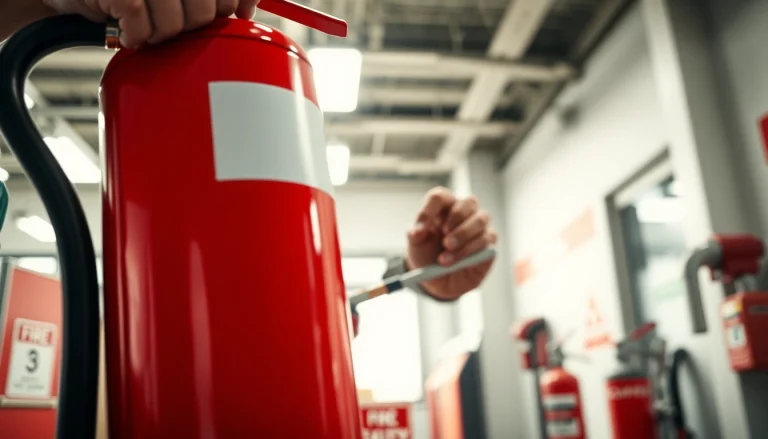
Introduction to Fire Extinguisher Servicing
Fire extinguishers are critical safety devices designed to combat small fires before they escalate into larger, potentially devastating blazes. They are often the first line of defense in protecting lives and property. However, their effectiveness is heavily reliant on regular and thorough fire extinguisher servicing. In this comprehensive guide, we will explore the various aspects of fire extinguisher servicing, ensuring that you understand what is necessary to keep your extinguishers in optimal condition.
Understanding Fire Extinguishers and Their Types
Fire extinguishers come in several types, each designed to combat specific kinds of fires. Understanding these types is essential for selecting the correct extinguisher for your needs:
- Water Extinguishers (Class A): Suitable for ordinary combustible materials like wood, paper, and textiles.
- Foam Extinguishers (Class A and B): Effective against fires involving flammable liquids such as petrol, oil, or paints.
- Dry Powder Extinguishers (Class A, B, and C): Versatile extinguishers useful against solids, flammable liquids, and gases.
- CO2 Extinguishers (Class B and Electrical): Ideal for fires involving electrical equipment and flammable liquids, as they do not leave residue.
- Wet Chemical Extinguishers (Class K): Specifically designed for cooking oils and fats, often used in commercial kitchens.
Each type of extinguisher is rated based on its effectiveness against specific classes of fires, which are categorized by the materials involved in the fire. Selection should be based on the potential fire risks present in the environment.
The Importance of Regular Servicing
Regular servicing of fire extinguishers is not just a regulatory obligation; it is a critical component of a proactive fire safety strategy. Fire extinguishers that are not serviced regularly may not function properly in an emergency. Here are some key reasons why servicing is crucial:
- Ensures Reliability: Regular checks prevent mechanical failure, ensuring the device is operational when needed.
- Compliance with Regulations: Many local and national fire codes require that extinguishers be serviced at least annually by a certified professional.
- Identifies Issues Early: Ongoing maintenance helps to identify problems like leaks, corrosion, or the need for recharging.
Failure to maintain fire extinguishers can lead to devastating consequences, including loss of life and property. Therefore, understanding the importance of regular servicing cannot be understated.
Legal Requirements for Fire Safety Compliance
Compliance with fire safety regulations is mandatory for businesses and organizations. National Fire Protection Association (NFPA) codes specify that fire extinguishers should undergo inspections, maintenance, and testing:
- Monthly Visual Inspections: Facilities are required to conduct a basic visual inspection of each extinguisher to verify that it is fully charged and accessible.
- Annual Maintenance: Fire extinguishers must be inspected and maintained by a professional annually.
- Periodic Testing: Certain types of extinguishers require detailed testing every six years, and refurbishment every 12 years.
Understanding these legal requirements not only safeguards the occupants of a building but also protects businesses from penalties and liabilities.
Steps for Effective Fire Extinguisher Servicing
Monthly Visual Inspections
The first step in ensuring the operational readiness of fire extinguishers is conducting monthly visual inspections. Key points to check include:
- Confirm that the extinguisher is in its designated location.
- Check for visible signs of rust, corrosion, or leaks.
- Verify that the pressure gauge is in the green zone, indicating a full charge.
- Ensure that the safety pin is intact and that labels are legible.
Documenting these inspections helps keep track of any changes in condition and is a key part of compliance with regulations.
Annual Professional Maintenance
Alongside monthly inspections, annual servicing by a licensed technician is essential. This process typically includes:
- Comprehensive checking of all internal and external components.
- Recharging and refilling the extinguisher if necessary.
- Ensuring that all pressure gauges are functioning and within the recommended range.
- Tagging the extinguisher with the date and results of the inspection.
Working with a professional ensures adherence to local fire codes and brings expert knowledge to the maintenance of your fire extinguishers.
Detailed Testing Procedures
Certain fire extinguishers require more than just routine inspections; they must undergo detailed testing procedures:
- Recharge Testing: This is required for extinguishers after they have been used and should be done immediately.
- Hydrostatic Testing: This tests the integrity of the extinguisher’s shell by pressurizing it. Hydrostatic testing must be performed every 5 to 12 years, depending on the type of extinguisher.
- Six-Year Maintenance: This involves discharging and recharging extinguishers to ensure they can operate effectively.
Performing these tests extends the functional lifespan of the extinguishers and helps maintain compliance with safety standards.
Common Issues and Troubleshooting Fire Extinguishers
Signs of Extinguisher Malfunction
Identifying potential malfunctions in fire extinguishers can be critical in preventing emergency failures. Common signs of malfunction include:
- Pressure gauge indicators in the red zone.
- Visible signs of damage, such as dents or cracks on the cylinder.
- Corrosion or rust that can compromise the integrity of the container.
- Missing or broken safety seals and pull pins.
Recognizing these issues can prevent a non-functional extinguisher from being used in an emergency.
How to Address Common Problems
Once issues have been identified, addressing them quickly is vital. For instance:
- If the pressure gauge is low, take the extinguisher to a certified technician for recharging.
- Replace any damaged or missing safety seals and pins to maintain operational readiness.
- Clean corrosion from the exterior, but ensure the internal components are thoroughly checked during professional maintenance.
Failing to address these issues promptly can lead to more severe problems down the line.
When to Replace Fire Extinguishers
Even with regular inspections and maintenance, fire extinguishers have a limited lifespan. It’s essential to know when to replace them:
- Extinguishers that have been discharged should be replaced immediately.
- Look for the manufacturer’s expiration date, which is often stamped on the label.
- If the extinguisher shows significant rust, corrosion, or physical damage, replacement is necessary.
Regular assessments can help in making timely decisions about replacements to ensure fire safety.
Fire Extinguisher Servicing Best Practices
Creating a Maintenance Schedule
Establishing a regular maintenance schedule is fundamental in fire safety management. Consider these steps:
- Create a calendar that aligns with monthly inspections, annual servicing, and six-year testing requirements.
- Assign accountability—designate a specific team member to oversee the maintenance of extinguishers.
- Utilize reminders or alerts for upcoming servicing dates to ensure nothing is overlooked.
A well-structured maintenance schedule ensures that fire extinguishers will always be ready for use when needed.
Documentation and Compliance Tracking
Documentation is essential for compliance and accountability. Maintain records of:
- Monthly inspections, including dates and findings.
- Annual service records with technician details and maintenance performed.
- Hydrostatic testing records to follow the timeline for future tests.
Having these documents on hand not only ensures compliance but also can greatly reduce liability in case of incidents.
Choosing Professional Fire Safety Services
Selecting a professional fire safety service provider is critical to the effective servicing of fire extinguishers:
- Research for accredited professionals with a solid reputation in your area.
- Inquire about their qualifications, certifications, and experience in the field.
- Request for detailed service agreements that outline what is included in their servicing.
Engaging the right professionals can provide peace of mind knowing that all safety protocols are in place and followed accordingly.
The Future of Fire Safety and Servicing
Emerging Technologies in Fire Safety
As technology evolves, so does fire safety. More businesses are beginning to integrate smart technology into their fire prevention systems:
- Smart fire alarms and extinguishers that can send alerts to your mobile device when maintenance is needed.
- Internet of Things (IoT) integration that allows for remote monitoring and management of fire safety equipment.
- Data analytics that help in assessingfire risk patterns, enabling tailored fire safety strategies.
Incorporating technology will help organizations to ensure compliance while streamlining fire safety management.
Trends in Fire Extinguisher Servicing
The fire safety industry is witnessing several distinct trends, from servicing practices to equipment innovations:
- Increased focus on eco-friendly extinguishing agents that are less harmful to the environment.
- Greater emphasis on training for employees, particularly in high-risk environments, to ensure proper extinguisher use.
- Utilization of digital platforms for scheduling, tracking maintenance, and compliance documentation.
Understanding these trends helps organizations remain competitive and compliant as regulations and technologies evolve.
Preparing for Changes in Fire Safety Regulations
Fire safety regulations are subject to updates; thus, staying informed is vital. Preparation can include:
- Regularly reviewing and updating safety policies to align with changing regulations.
- Participating in professional organizations or local fire safety boards to remain engaged with sector changes.
- Conducting periodic staff training sessions to discuss updates in regulations and safety practices.
Preparation is the key to maintaining compliance and ensuring a safe environment for all building occupants.
Conclusion
Fire extinguisher servicing is not just about meeting regulatory requirements—it is about ensuring safety, protecting lives, and minimizing property damage. Regular inspections, professional maintenance, and meticulous documentation are the cornerstones of an effective fire safety strategy. Additionally, staying informed about emerging trends can enhance safety practices and compliance efforts. By prioritizing fire extinguisher servicing, you not only adhere to legal obligations but also foster a safety culture within your organization.





